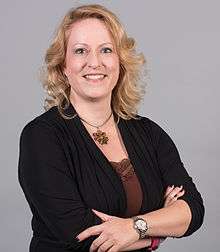Esther de Lange

Esther de Lange (Dutch pronunciation: [ˈɛstər də ˈlɑŋə]; 19 February 1975 in Spaubeek) is a Dutch politician for the Christian Democratic Appeal (CDA). Since April 2007 she has been a MEP. De Lange was elected as party leader for the CDA in the European Parliament during a party conference on 2 November 2013 in Leeuwarden.
After the European elections, 2014 Esther de Lange was elected one of the vice presidents of the EPP Group in the European Parliament, responsible for the relations with national parliaments. She is a member of the committee for Economic and Monetary Affairs (ECON) and of the committee for Industry, Research and Energy (ITRE). De Lange is also member of the delegations for the EU-relations with the US and with Russia. Previously she was a member of the committee for Environment, Public Health and Food Safety committee (ENVI); the commission on Agriculture and Development (AGRI) and the commission that focuses on Budgetary Control (BUDG). Besides that, De Lange was a member of the Delegation for relations with India and she is also Vice-Chair of the Delegation for the relations with Iraq.
In her parliamentary work, De Lange mostly focused on agriculture, food safety and sustainability. Under the 2009-2014 mandate, she has been actively involved in the revision of the Common Agricultural Policy (CAP). De Lange has been acting as rapporteur on the dossier of food labeling and nutrition for special (medical) use in the European Parliament. In 2013, De Lange acted as the European Parliament’s rapporteur on the highly controversial issue of food fraud in the EU. She managed to get publicity in a presentation of a report on food fraud by declaring that industrial calamares are often made from pig recta.[1] The story turned out to be based on rumors and there was no information in the report to indicate that pig recta were actually used for calamares.[2]
References
- ↑ "Inktvisringen vaak gemaakt van varkensanus" (in Dutch). De Telegraaf. 17 October 2013. Retrieved 2 November 2013.
- ↑ "Inktvisringen van varkensanus is waarschijnlijk broodje aap" (in Dutch). De Telegraaf. 18 October 2013. Retrieved 2 November 2013.
External links
- (Dutch) Parlement.com - biography
- (Dutch) Estherdelange.nl - personal website